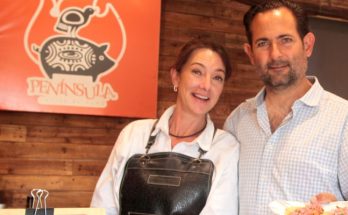By Carolina de la Cajiga
All visual art begins in the mind. In their own way, each creator converts their fantasies into tangible objects. Carmen Jiménez transforms her reveries into utopian or fantastic sculptures that give the impression of movement. Her dominant influences are Michelangelo, Bernini, and Leonardo da Vinci, the great masters of the Renaissance. From there, Carmen jumps to the heyday of modern art, at the end of the 19th and beginning of the 20th centuries. Her favorite artists from that time are sculptors Camille Claudel and Auguste Rodin.
Ever since she was little, Carmen devoured the art books that abounded in her house, as she comes from a family of artists. For a long time, her heart was torn between ballet and art. For 15 years she studied ballet with dedication, until the day she came for a visit from her native León to San Miguel. The artistic and bohemian atmosphere of the town captivated her, and she never left. She joined Instituto Allende, where she studied and graduated with a degree in visual arts. In 2006 she began teaching anatomical drawing and painting at Bellas Artes. Always restless, she soon established her studio. In addition to working on her creations, she started teaching clay sculpture. Her students range from beginner to advanced. She takes just a few, so she can give each one all her attention.
It’s obvious that ballet influences her sculptural work. Her pieces seem to have an organic warmth; they almost pulsate and spring to life. Carmen explains, “I feel in my gut every moment of the creative process. The pieces combine the four elements—earth, water, air, and fire—as well as the spirit.” She further elucidates, “My deep knowledge of the body and its movement is essential to achieve the effect of ‘paused fragments’ that distinguish my sculptures.”
The two materials Carmen loves the most are clay and bronze, totally opposite in their handling, both antagonistic forces. Clay is versatile and malleable. When kneading, it conveys a sense of serenity that invites meditation. Bronze is born from fire; it radiates heat and electricity. It is an alloy of copper, tin, and other metals that make it inflexible, brawny, and unyielding. Working with clay is an intimate exercise between the artist and the medium. It’s like a natural birth. In contrast, bronze is a social activity that involves the artist and those who make the molds, the cast, the polishing, and the patina.
Describing the stages, from conception to the finished piece, Carmen explains, “Once the idea coalesces, I make numerous sketches, each one more precise, until I find the right way to convert my concept into something plausible. At this point I determine if I’ll require models. The next step is to make the final sketch to scale. Depending on the complexity and where the sculpture will be installed, I decide which material is the best for the piece. If this is a commission, the client and I discuss the final details, and I finally get going.” For Carmen this moment is like the start of a race. «My body and mind tense. I’m an explosion of energy, focused and ready to go,» she affirms.
One of her first commissions helped Carmen move from small pieces to large, monumental sculptures. “It was a great challenge that I accepted even though I wasn’t sure how I would do it. The commission was a meter-high torso.” Still excited, Carmen shares what happened, “I built an armature to hold the clay. After 10 hours of nonstop work, exhausted, I covered it to prevent it from drying out and went to bed. I could hardly sleep from the excitement. The next morning, when I opened the studio door, there was no sculpture. Puzzled and surprised, I walked towards where I had left the piece, only to find 70 kilos of clay on the ground. My frame hadn’t been strong enough to sustain the weight. With my alas caídas (droopy wings, momentarily defeated) but determined to triumph, I researched until I found the right way to hold the structure upright. This was an important lesson. After overcoming the frustration, I finished the piece. As a result of this experience, I’ve made many large-format sculptures and have never had this issue again.”
Each sculpture is unique, some her ideas, others commissions. She never makes duplicates. The length of time to finish depends on the complexity, the size, and the material. It can take from a few days up to two months. Carmen points out, «The last touches require special attention.»
“Beauty Beyond Size” is the new direction Carmen is thrilled about these days. “These are clay sculptures that celebrate the magnificence of the female body. They break standards of beauty. The sculptures show intimate moments, from stillness to acrobatic movements.” This series will be exhibited in 2023 in a sculpture garden in San Miguel de Allende. Stay connected with Carmen and, of course, with Atención to find out more.
“Making sculptures is not my job, but my passion,” Carmen declares. «Being in my studio every day, busy with my work and that of my students, fulfills me.» She states she’ll continue making sculptures or other activities related to art until the last of her days. To achieve success, she believes one should do it repeatedly and intentionally. “The desire to continue improving is the difference between a professional and an amateur. Never stop experimenting and learning. This applies in the art world or any other field,” she exclaims emphatically.
Carmen’s social networks are carmenjimenez.escultora on Instagram and Carmen Jiménez Art Studio on Facebook. For more information: carmenbellasartes@gmail.com.
If you know someone you would like us to interview, please send us their contact information to editorial@atencionsanmiguel.org.




